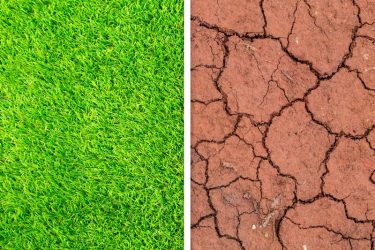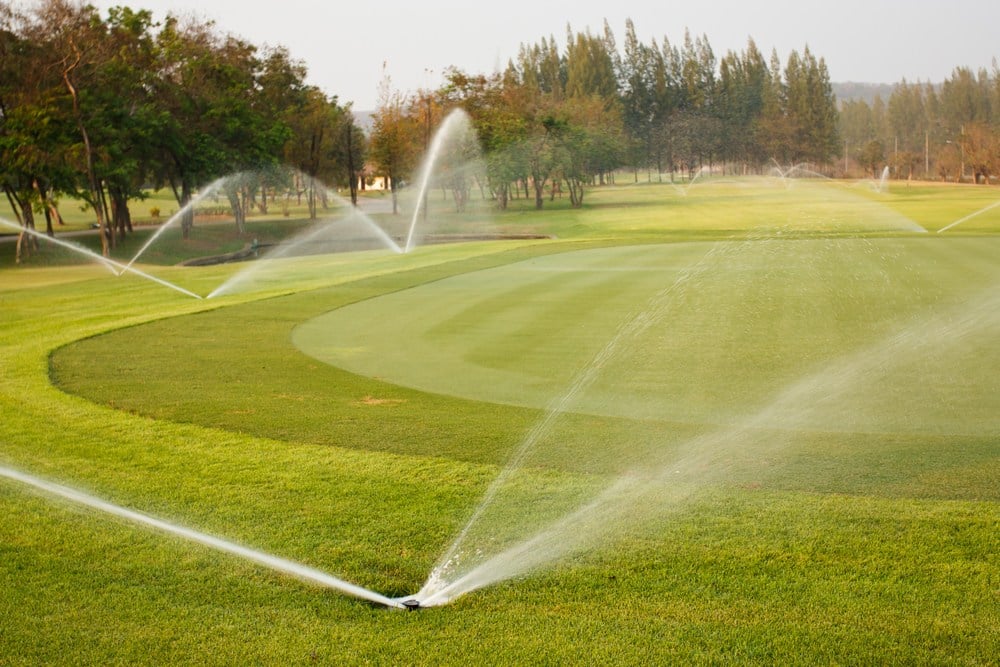







Calcium helps plants absorb nutrients. In simplified terms, calcium is a nutrient carrier in both the soil and the plant tissue6 . In the soil, it helps control the water movement and conductivity, which means it can deliver more nutrients from the soil and maximize fertilizer effectiveness. In plants, calcium helps regulate water and nutrient uptake by the roots and the movement throughout the plant.
This results in a greener field turf with improved drainage and the need for less irrigation water to maintain the thick, plush grass desired.


- How do I prevent crusting of the soil during the warmer summer months?
- Soil crusting arises from unaggregated clay particles common in tough summer weather conditions. EcoGEM’s Soil Enhancer stabilizes the soil surface into large aggregates or peds that prevent crusting, and in turn, helps reduce the spread of weeds (like poaannua) and also reduces runoff and erosion holding the water in the soil for plant use.
- How do I reduce my fertilizer usage and cost?
- By enhancing soil structure which creates microscopic channels in the soil, EcoGEM’s Soil Enhancer increases soil water infiltration rates 3-5 times over non-treated soils, holds nutrient and reduces the runoff of these fertilizers into ponds and waterways. This better infiltration allows the fertilizer to reach the lower root level and enables better absorption into the plant. This allows you to reduce fertilizer usage and costs. It is what also minimizes the fertilizer run-off.
- How can I reduce my water requirements and costs?
- EcoGEM’s Soil Enhancer improves water infiltration 3-5 times on treated soils reducing compacted soils that harm root systems and prevent the uptake of moisture and oxygen. The enhanced soil increases the permeability of the water into the soil (reducing evaporation) and holds the water in the soil for current and future plant use.
- This generates Cost Savings by reducing water usage requirements (and associated maintenance/utilities/downtime), turf repairs, and minimizes the fertilizers needed for the same results.
- How can I improve drainage after a heavy rainfall or overwatering?
- Poor water drainage or overwatering is a common problem which can stress root zones in grasses and turfs. This makes the soil more prone to compaction which prevents water from infiltrating the soil and get to the root zone. By improving the soil structure, EcoGEM’s Soil Enhancer can create those microscopic channels that allows to better permeate the soil and minimize compaction and water remaining on the surface of the ground.







Stadium Field Management

Stadium field management must be knowledgeable when it comes to the damage that can be caused by the stresses of cold weather, heat and wind. The turf found in stadiums needs to be healthy enough to be able to repair itself quickly after damage has occurred. Aerification is recommended when it comes to stadium field management. It is important that soil compaction be relieved through stadium field management solutions like using our gypsum products.
With our solutions for stadium field management, gypsum is applied in order to reduce soil crust formation and improve the infiltration rate of water into the soil.
We offer solutions for turfs when it comes to:
- Field turf management
- Golf course mangement
- Playground turf management
- Stadium field management
For your needs for stadium field management and more, get in touch with the experts at EcoGEM.
(303) 500-6944
Playground Turf Management

Using our organic calcium sulfate products has a great benefit and proven effect as part of playground turf management. Playground turf management managers across the country are searching for playground turf management practices in order to reduce the costs of their utilities and maintenance. Enhancing the rooting and reducing the run-off of phosphorus and nitrogen have been proven positive effects of our products for playground turf management.
Our experts of playground turf management would be happy to address your questions and concerns regarding finding the right solutions for the managing of turf for your property. Reach out to us today and find out the products that we offer to help you.
Turn to use for playground turf managements solutions like:
- Improve drainage after rainfall
- Prevent crusting of soil
- Free movement of moisture in soil
- Create contaminant free root-zone
Call EcoGEM today for your needs and questions regarding playground turf management.
(303) 500-6944
Field Turf Management

The importance of calcium sulfate in any field turf management system cannot be overstated. It is important to provide proper nutrients and essential cation in soil. It is often ignored in field turf management.
With our calcium sulfate solutions for field turf management, a healthy root system is a result. Highly trafficked fields are able to withstand the traffic due to the field turf management products we provide. Calcium is an important element in any turf environment. Our field turf management experts can help you decide if these products are necessary for your turf.
When it comes to field turf management, turn to us for these key benefits:
- Reduce fertilizer usage
- Reduce fertilizer cost
- Reduce water requirements
- Reduce cost of water
For field turf management solutions, get in touch with EcoGEM today.
(303) 500-6944




1 Chen and Warren Dick; 2011 from "Gypsum as an Agricultural Liming Amendment. http://ohioline.osu.edu/b945/b945.pdf"
2Oster J.D., (1982) Gypsum usage in irrigated agriculture: A review. Fertilizer Research 3, pp73-89 (1982).
3Dr. L. Oldham (2019) Secondary Plant Nutrients: Calcium, Magnesium, and Sulfur. Mississippi State University Extension, MS 39762. Information Sheet 1039 (POD-07-19)
4 McCauley A., Jones C., Jacobsen J. (2009) Plant nutrition functions and deficiency and toxicity symptoms, Montana State University Extension Service, Bozeman, MT. pp.16
5Loveday J. (1981) Soil Management and amelioration. Abbot TS, Hawkins CA and Searle, PGE, eds. National soils conference 1980. Review Papers, pp 39-57. Glen Osmond, Australia: Australia Society of Soil Science Inc.
6Maathuis F.J.M. (2009) Physiological functions of Mineral Macronutrients. Current Opinion in Plant Biology 12:250-258

